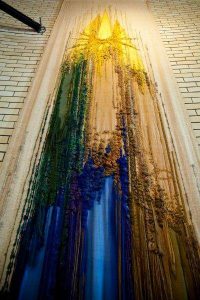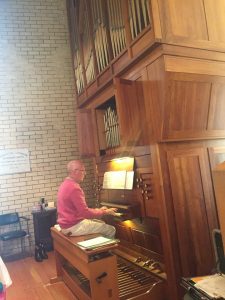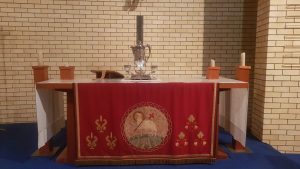The present church building was designed by architect Barry Walduck (d. 2013) and was erected in 1976 as a response to the ‘island’ site created by land resumption and the amalgamation of the two previous congregations in the city. Walduck was possibly influenced by Brisbane architect and town planner Karl Langer (1903–1969), an Austrian refugee from the Nazis. Contemporary sculptural architecture shapes the building exterior while the interior features yellow Oregon pine.
The main features:
The Christus Rex memorial cross
This is on the liturgical east wall and signifies, among other things, the Christ who comes to us and sustains us on our journey and receives us at the end of our journey. From an original concept by Paul Renner, it was crafted by artist and sculptor Nickolaus Seffrin for the 25th anniversary of the church building in 2001.
The Holy Spirit Mural
The split 'tongues of fire' are a reminder of Pentecost, with the seven flames symbolising the seven days of creation. This is brought to the number eight by the coming of the Holy Spirit, like a dove, descending from heaven. God's new creation in his risen Son began after seven days. The first day of the week (Sunday) is thus the eighth day of creation and at the same time the first day of the new creation. Hence the eighth flame on the Paschal candle stand. The mural was crafted by Nickolaus Seffrin in 1989 and presented to the congregation in memory of Andreas and Minna Kraatz.
The resurrection wall hanging
The resurrection wall hanging is located behind the pulpit and near the altar. Embroidered and appliqued, it represents in abstract form the message of the resurrection. The base fabric is raw silk with silk panels and embroidered threads and Australian hand-dyed wool.
Bethlehem memorial organ
The organ is a neo-classical mechanical action pipe organ with 17 stops. Built by Danish-born Knud Smenge of Melbourne, it was dedicated on 19 August 1990 by Pastor HVP Renner. It was constructed in memory of Bethlehem Lutheran Church, Warren Street – the sale of which funded the organ.
Red altar cloth
It depicts 'A Lamb goes uncomplaining forth' (See LHS hymn 57 by Paul Gerhardt). This old altar cloth was salvaged by Sieg Monz in the 1970s from a pile of ‘rubbish’ when the previous St Andrew’s church building was demolished. It was imported by the ladies guild in 1912 for the 50th anniversary of the first church on the site (1861) observed a year late. It was made usable again by Corinne Marron and her mother Lois Noller. Those who contributed 'gifts of love' towards it in 1912 were Mr Kleinschmidt Sr and Jr; Mrs Dittberner; Mrs Austin; Mrs Rüthning; Mrs E Wendt; Mrs Dirtbern; Mrs Freudenberg; Mrs Fabian; Mrs Seipel; Mrs Bergemann; Mrs Heike; Mrs C Beckmann; Mrs Jungnickel; Mrs Lemke; and Mrs Forer.
Prayer bowl
The prayer bowl arose out of our annual celebration of All Saints Day. It is a small tangible aid for two reasons:
- It is for those who wish to light a candle in memory of a loved one who has died in Christ and is now in the presence of God, eternally worshipping with us. In the service with communion, we sing the following:‘... therefore with angels and archangels and all the company of heaven’ (see Luke 10:20; Hebrews 12:22–24; Revelation 7:9–17 and 21–27).
- It is also for those who desire to light a candle as a tangible action in response to someone who has asked for prayers to be said for them. Perhaps they live on the other side of the world. Or this might be for someone at your school or at work. This may also be for someone who is unable to pray for themselves, for all kinds of reasons. So we ‘carry’ them into God’s presence. For our priestly role, which is vicarious, as the body of Christ, see Ephesians 2:18 and Romans 5:2.
Processional cross
It features the Christus Rex motif. It was crafted by Nickolaus Seffrin and was presented to the congregation in 2005. It was consecrated on the fourth Sunday of Advent. The processional cross is brought to the chancel by a crucifer at the beginning of special services to represent the presence of the Lord who has been with us in the world on our journey. The processional cross then leads us back out into the world as we recess, where the liturgy continues in the world, Christ being with us.
In 2007, to complete the motif, a crown for this cross was crafted by Danish-born Jürgen De Voss of Brisbane, and it was presented by the original benefactors, Denis and Melitta Gardner.
The Luther Window
The Luther stained glass window located in the gallery is form the previous church building. It was imported from Germany for the 50th anniversary of the first church building, observed on the 28th April, 1912. In the window are 3 joining circles symbolising the Holy Trinity. Martin Luther is depicted, with the Scriptures, open to Psalm 18:2,3. The "Luther Rose" is also depicted.
Three Carved Wooden Mice
Pastor Paul Renner, who ministered at St Andrew the Apostle from 1981 - 1986, would feature three mice, Max, Morris, and their little sister Martha, in his children’s addresses. As a tangible presence of these three mice, the Church Council decided in 2013 to place three wooden mice representing Max, Morris and Martha discreetly within the church as a commemoration of Pastor Renner’s time at St Andrew the Apostle.






